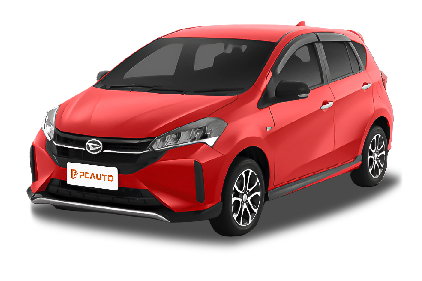Q
What engine is in the Daihatsu Sirion?
In the Malaysian market, the Daihatsu Sirion is mainly equipped with two naturally - aspirated gasoline engines: 1.3-liter and 1.5-liter. The 1.3-liter engine, with the model number K3-VE, features a DOHC 16-valve design. It has a maximum output power of about 86 horsepower, which is suitable for city driving and offers excellent fuel economy. The 1.5-liter engine, coded 3SZ-VE, also uses DOHC 16-valve technology, with a maximum power of up to 109 horsepower. It provides more abundant power and is suitable for users who need stronger acceleration performance. Both of these engines are well-known for their reliability and low maintenance costs, which aligns with Daihatsu's consistent positioning of being economical and practical.
As a small hatchback, the Sirion is favored by urban users in the Malaysian market for its flexible body size and high-efficiency fuel consumption, especially suitable for congested urban road conditions. For Malaysian consumers, choosing the Sirion not only allows them to enjoy the high-quality of Japanese cars but also benefits from its relatively low repair and maintenance costs. Meanwhile, the 1.5-liter version also offers a smoother high-speed driving experience, meeting the needs of occasional long - distance trips.
Special Disclaimer: This content is published by users and does not represent the views or position of PCauto.
Related Q&A
Q
How many litres is a Daihatsu Sirion?
As an economical and practical small car, the Daihatsu Sirion is well-received by many consumers in the Malaysian market for its fuel efficiency and flexible handling. The engine displacement of the Daihatsu Sirion varies according to different years and versions. For early models, such as the 1.3-liter version from 2004 to 2009, it is equipped with a 1.3L K3-VE engine (about 1.3 liters), while the 1.5-liter version uses a 1.5L 3SZ-VE engine (about 1.5 liters). Subsequent facelifts may also continue with similar configurations. Specifically, it is necessary to refer to the actual vehicle nameplate or the official manual.
For Malaysian users, this kind of small car is very suitable for urban commuting. It not only has high fuel efficiency but also relatively affordable maintenance costs. At the same time, as a technical partner of Perodua, Daihatsu has a well-established local after-sales service network and an abundant supply of parts.
If you are considering a used car or vehicle maintenance, it is recommended to regularly check the capacity of the engine oil and coolant and follow the maintenance cycle recommended by the manufacturer to ensure the long-term stable operation of the vehicle. Although engines with small displacements like these have moderate power, proper maintenance can significantly extend their service life.
Q
How long does a Daihatsu Sirion last?
As an economical and practical small car, the Daihatsu Sirion is favored by many car owners in the Malaysian market for its durability and low maintenance costs. Its service life mainly depends on daily maintenance and driving habits. Under the condition of regularly replacing consumables such as engine oil and filters and following the manufacturer's maintenance manual, it can usually travel over 150,000 to 200,000 kilometers. Some well-maintained vehicles can even exceed 250,000 kilometers.
The hot and rainy climate in Malaysia has a certain impact on rubber parts and electronic components. It is recommended to regularly check easily-aging parts such as belts and sealing strips, and pay attention to cleaning the cooling system to prevent overheating. The 1.3L and 1.5L engines equipped in this car have mature technologies, with sufficient supply of spare parts at affordable prices, which is very beneficial for long-term use.
It's worth noting that small cars have the advantage of flexible parking on Malaysian city roads. The fuel economy of the Sirion (about 15-18 km/L) is particularly practical for local users who often face oil price fluctuations. If you plan to buy a used Sirion, it is recommended to focus on checking the condition of the gearbox and the rust situation of the chassis, which are common concerns for high-mileage vehicles in tropical regions.
Q
What is the difference between Daihatsu Boon and Sirion?
The Daihatsu Boon and Sirion are two small cars with different positioning, and the main differences lie in their design and market positioning. The Boon is more inclined towards being an economical and practical vehicle. It has a compact body, which is suitable for city driving, and it offers excellent fuel consumption performance. The interior is simple and focuses on functionality, making it a good choice for consumers with limited budgets.
On the other hand, the Sirion is positioned slightly higher. It has a more stylish exterior design, uses more refined interior materials, and features a more flexible space layout. It is suitable for family users who pursue both comfort and practicality. Both cars are equipped with Daihatsu's reliable engine technology, but the Sirion usually comes with a more comprehensive range of configurations. For example, it may be equipped with more safety technologies or entertainment systems.
In the Malaysian market, both models have been popular for their affordable prices and low maintenance costs. However, the specific choice depends on individual needs. The Boon is suitable for daily commuting, while the Sirion is more suitable for users with higher quality requirements. Additionally, as a member of the Toyota Group, Daihatsu models have a good reputation for durability and after-sales support, which is also an important factor for Malaysian consumers to consider.
Q
What is the fuel economy of the Daihatsu Sirion?
As a practical and economical small car, the Daihatsu Sirion performs well in fuel economy. The specific fuel-consumption data will vary depending on different years and engine configurations. Generally, for models equipped with a 1.3L or 1.5L engine, the fuel consumption is about 6-7 liters per 100 kilometers under city driving conditions, and it can drop to around 5-6 liters per 100 kilometers when driving on the highway. Overall, it's suitable for daily commuting and family use.
For Malaysian consumers, considering the local road conditions and fuel prices, the fuel-saving feature of the Sirion can help reduce the cost of car use. It's especially suitable for users with limited budgets who still need a reliable means of transportation. Moreover, it's quite convenient to drive and park a small car in Malaysian cities. Additionally, the Daihatsu brand has a well-established after-sales service network locally, so the maintenance is also relatively cost-effective.
If you have higher requirements for fuel economy, you can also pay attention to the regular maintenance of the vehicle. For example, keep the tire pressure normal and replace the air filter regularly. These small details can further optimize the fuel-consumption performance.
Q
What is the engine capacity of the Daihatsu Sirion?
The Daihatsu Sirion is a sister model of the Perodua Myvi. Its engine capacity varies according to different years and versions. Early models, such as the 2005 version, were equipped with a 1.3-liter K3-VE engine (1298cc), while later versions, like the 2010 model, were upgraded to a 1.5-liter 3SZ-VE engine (1495cc). Both of these engines are well - known for their fuel efficiency and durability, making them suitable for the urban road conditions in Malaysia.
It's worth noting that the Sirion shares powertrain technology with the Myvi. As a result, the maintenance costs are relatively low and there is an abundant supply of parts, which is very practical for Malaysian car owners. Engine capacity is one of the important indicators for measuring a car's power output. Generally speaking, the larger the displacement, the stronger the power, but the fuel consumption will also increase accordingly. The 1.3-liter and 1.5-liter engines of the Sirion have achieved a good balance between power and fuel economy, which is also one of the reasons for its popularity in the Southeast Asian market.
For Malaysian consumers who want to buy a second-hand Sirion, it is recommended to choose the appropriate displacement according to their daily driving needs. If you often drive long distances, you can consider the 1.5-liter version, while the 1.3-liter version is more economical if you mainly use the car for urban commuting.
Q
How many cylinders does a Daihatsu Sirion have?
As an economical and practical small car, the Daihatsu Sirion is popular in the Malaysian market for its fuel efficiency and nimble handling. Its engine configurations vary depending on the model and year. The common versions are equipped with 1.3-liter or 1.5-liter naturally aspirated engines, both featuring a 4-cylinder design. This kind of configuration is quite common in small cars, capable of balancing power output and fuel economy, which is ideal for city driving.
The 4-cylinder engine has a simple structure, low maintenance costs, and good running smoothness, making it the top choice for most family cars. For Malaysian consumers, such a configuration can not only meet the daily commuting needs but also reduce long-term usage costs. Moreover, the lightweight body of the Daihatsu Sirion, paired with the 4-cylinder engine, further improves fuel efficiency, making it highly suitable for the stop-and-go traffic conditions in Malaysia.
If you're interested in engine technology, you can keep an eye on the new models launched by Daihatsu in recent years. Some of them adopt the more advanced DVVT (Dual Variable Valve Timing) technology, which optimizes the low-speed torque and high-speed power performance. However, the classic 4-cylinder design of the Sirion remains a practical option.
Q
Is the Daihatsu Sirion petrol or diesel?
In the Malaysian market, the Daihatsu Sirion is mainly available in gasoline engine versions, and no diesel models have been launched. This small car is popular among local consumers for its cost-effectiveness and low fuel consumption, making it particularly suitable for city commuting. The 1.3L or 1.5L gasoline engines equipped in this car adopt the DVVT (Dual Variable Valve Timing) technology. This technology optimizes fuel efficiency while ensuring power output, meeting the needs of Malaysian users for daily commuting vehicles
It's worth noting that the Malaysian automotive market is dominated by gasoline-powered cars. This is mainly influenced by the government's fuel subsidy policy and the relatively high maintenance costs of diesel cars. Therefore, most Japanese small cars are launched with gasoline versions first. For buyers with a limited budget who value durability, the Sirion's gasoline engine combined with a lightweight body design can achieve an actual fuel consumption of over about 15 km/L. Its engine technology has also been proven in the market for a long time, and the local parts supply and repair network are quite well-established.
If we consider diesel cars, the Malaysian market focuses more on pickups or large SUVs. These types of vehicles require higher torque to handle the load, while city cars like the Sirion usually don't need the extra low-end torque advantage of diesel engines.
Q
Is the Daihatsu Sirion a reliable car?
As a compact car focusing on economy and practicality, the Daihatsu Sirion is quite popular among many consumers in the Malaysian market for its fuel-efficiency, agility, and low maintenance costs. Its reliability generally meets the consistent standards of Japanese cars of this brand.
The Sirion is equipped with a 1.3L or 1.5L naturally-aspirated engine with mature technology. Coupled with a lightweight body design, it shows excellent fuel economy during urban commuting. Meanwhile, the simple mechanical structure also reduces the failure rate during long-term use, and the daily maintenance cost is relatively affordable, making it suitable for family users with limited budgets.
However, it should be noted that if some early models lack regular maintenance, there may be problems such as aging of the suspension system or occasional issues with small electronic components. It is recommended to give priority to vehicles with a complete maintenance record when buying a second-hand Sirion.
For Malaysian consumers, the supply of Sirion parts is relatively abundant, and the maintenance convenience is better than that of some niche models. But we also need to view rationally the common shortcomings of compact cars, such as the sound insulation effect and high-speed stability.
If you are looking for higher-end configurations or more refined interiors, the Perodua Myvi or Honda Jazz in the same class may be worth comparing. However, the Sirion is still a practical choice for basic transportation needs, especially suitable for users who value practicality and vehicle maintenance costs.
Q
Which country made Daihatsu Sirion?
The Daihatsu Sirion is a compact car produced by Daihatsu Motor Company, a Japanese automaker. This brand belongs to the Toyota Group and is well-known for manufacturing economical and practical small cars. The Sirion was first introduced in the 1990s, mainly targeting the Asian and European markets. Its design focuses on fuel economy and flexibility for city driving, making it highly suitable for the traffic environment in Malaysia.
In Malaysia, the Sirion was once sold through local assembly (CKD). Some models were equipped with 1.3-liter or 1.5-liter engines that met local requirements, achieving a good balance between power and fuel consumption. It's worth mentioning that as a subsidiary brand of Toyota, Daihatsu has advantages in technology sharing and parts supply. This results in relatively low maintenance costs for the Sirion, and its parts are easier to obtain in the Malaysian market.
Although the Sirion has gradually been replaced by new-generation models, its durability and practicality are still recognized by many Malaysian car owners, and it can still be seen in the second-hand market. For consumers with a limited budget who need a reliable means of transportation, the Sirion used to be a great choice.
Q
What is the fuel consumption of the Daihatsu Sirion?
As an economical and practical small car, the Daihatsu Sirion boasts quite good fuel economy. The specific fuel consumption varies according to different production years and engine configurations. Generally speaking, the urban fuel consumption of the 1.3-litre and 1.5-litre engine versions is around 6 to 7 litres per 100 kilometers, and it can drop to 5 to 6 litres per 100 kilometers when driving on the highway. The actual figures are also affected by driving habits, road conditions, and the vehicle's maintenance status.
For Malaysian consumers, this car is highly suitable for urban commuting. It not only has low fuel costs but also relatively affordable maintenance expenses, making it a great value-for-money option. Moreover, the compact body design of the Daihatsu Sirion makes it extremely maneuverable on Malaysia's narrow streets and in crowded parking lots. At the same time, its reliable quality and low fuel consumption meet the local consumers' requirements for economical vehicles.
If you're considering buying a fuel-efficient and practical small car, the Daihatsu Sirion deserves to be on your shortlist. It's recommended that you take a test drive before purchasing to better understand its actual driving experience and fuel consumption performance.
Latest Q&A
Q
How much should I pay for a 2018 Hyundai Elantra?
The price of a 2018 Hyundai Elantra in the used car market typically ranges from RM55,000 to RM75,000, depending on factors like vehicle condition, mileage, trim level, and service history. Higher-spec 1.6L Sport or 2.0L variants might hit the upper end of that range, while base models or those with higher mileage will be cheaper. It’s advisable to get a professional inspection before buying to check the vehicle’s condition, especially critical components like the engine, transmission, and chassis. Also, verify insurance and road tax records to ensure there are no unresolved accidents or outstanding payments. As an economy sedan, the Elantra is known for its fuel efficiency and reliability, but used prices for different model years are also affected by new car market competition and model updates. So, it’s a good idea to compare quotes from multiple dealerships or private sellers and check if there’s any remaining factory warranty or extended warranty coverage, as these can impact the final transaction price. Additionally, used car loan interest rates and transfer fees should be calculated in advance to avoid exceeding your budget.
Q
Are 2018 Hyundai Elantras reliable cars?
The 2018 Hyundai Elantra delivers above-average reliability. Its powertrain uses proven 1.6L or 2.0L naturally aspirated engines paired with a 6-speed automatic transmission—a combination that's been market-tested, boasting low failure rates and reasonable routine maintenance costs. The suspension tuning leans toward comfort, making it well-suited for local road conditions, though some owners note that the sound insulation is just so-so, with noticeable tire noise at highway speeds. The Elantra's electronic systems are fairly stable, but if you're buying used, it's smart to thoroughly check that the AC system and infotainment screen are working properly. Safety features are pretty basic on this model: you get 6 airbags and stability control, but more advanced driver-assistance tech is missing. In its class, it holds its value at a mid-pack level, with a wide service network and plenty of available parts. If you're considering a used one, aim for lower mileage with complete service records, and keep an eye out for common issues like transmission hesitation or engine abnormal noise. All in all, the 2018 Elantra works well for shoppers on a budget who want a hassle-free daily driver—it offers solid all-around performance that matches its price point.
Q
How much is S70 2024 in Malaysia?
Pricing details for the 2024 Volvo S70 haven't been officially announced yet, but looking at the current S60's price range (around RM250,000 to RM300,000) and the brand's recent pricing strategies, we can expect the S70 to start at roughly RM280,000, with higher-spec variants possibly approaching RM350,000. The new model is set to carry forward Volvo's family design language and will likely feature an upgraded plug-in hybrid system – the T8 Recharge version, for instance, might deliver over 400 horsepower combined. Standard tech should include the City Safety active safety suite and Pilot Assist semi-autonomous driving aids. It's worth noting that rivals like the BMW 3 Series and Mercedes-Benz C-Class have also rolled out mild-hybrid models lately. When comparing options, shoppers should pay attention to differences in hybrid tech approaches (like 48V mild hybrids versus plug-in hybrids) and after-sales warranty policies (some brands offer 5-year/unlimited mileage coverage). If you're interested, keep an eye on the upcoming Kuala Lumpur International Motor Show or reach out to authorized dealers directly to schedule a test drive – get hands-on with the Nordic luxury sedan's driving feel and signature features like those ergonomic seats.
Q
What is the price of Honda Jazz in 2019?
Prices for the 2019 Honda Jazz in local markets vary by trim level. The base 1.5E manual starts around RM70,000, while the top-spec 1.5V Sensing CVT gets close to RM90,000 – exact figures might shift with dealer promotions or optional extras. It keeps Honda's classic practical design, packing a 1.5-liter i-VTEC engine with Earth Dreams tech that balances fuel efficiency with 131 hp, making it perfect for city drives. The standout feature? Jazz's iconic ULTRA seat system with its multiple folding setups – fold the rear seats down and you get a completely flat cargo area. That "magic seat" space concept still shines in its class. The 2019 model also added Honda SENSING on higher trims, bringing features like collision mitigation braking and lane keep assist – pretty advanced stuff for its segment back then. Looking at the used market, the 2019 Jazz holds value steadily. Well-maintained examples typically retain about 60-70% of their original price, thanks to its solid reliability reputation and affordable upkeep costs.
Q
What is the power of Honda Jazz 2019?
The 2019 Honda Jazz comes with a 1.5-liter i-VTEC naturally aspirated engine locally, churning out 120 horsepower (around 89 kW) and 145 Nm of peak torque. It's paired with either a CVT or a 6-speed manual gearbox, delivering smooth, fuel-efficient performance that's perfect for city driving. Built on Honda's classic global small car platform, the Jazz features lightweight construction combined with Earth Dreams technology, resulting in impressive fuel economy—around 5.5L/100km combined. What really stands out is its "Magic Seat" design; despite being a small car, the interior flexibility beats most rivals. Fold the rear seats flat, and you get a huge cargo area. Safety-wise, it gets VSA vehicle stability control, HSA hill-start assist, and higher trims even come with the Honda SENSING active safety suite. When stacked against competitors like the Toyota Yaris and Mazda2, the Jazz holds its own in power figures, but Honda's edge in space utilization and resale value is what keeps it a long-time favorite. If you crave more pep, keep an eye out for the later Jazz RS sport variant, which gets a more performance-focused tune.
View More


















Pros
Cons